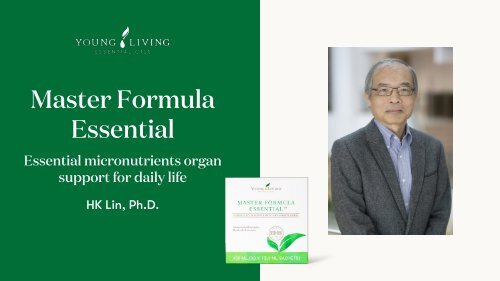Master Formula Essential with Dr Lin
Master Formula Essential - Presentation with Dr Lin
Master Formula Essential - Presentation with Dr Lin
Create successful ePaper yourself
Turn your PDF publications into a flip-book with our unique Google optimized e-Paper software.
<strong>Master</strong> <strong>Formula</strong><br />
<strong>Essential</strong><br />
<strong>Essential</strong> micronutrients organ<br />
support for daily life<br />
HK <strong>Lin</strong>, Ph.D.
Modern, agricultural practices designed<br />
to improve product size, growth rate<br />
and pest resistance have resulted in the<br />
reduction in the amount of protein,<br />
calcium, phosphorus, iron, riboflavin<br />
(vitamin B2) and vitamin C over the past<br />
half century.<br />
The study was based on U.S.<br />
Department of Agriculture nutritional<br />
data from both 1950 and 1999 for 43<br />
different vegetables and fruits.<br />
Medical Research Council, Ministry of Agriculture Fisheries<br />
and Foods & the Royal Society of Chemistry (1991)<br />
Davis et al., J Am Coll Nutr 23, 669-682, 2004
“Most people do not consume<br />
an optimal amount of all<br />
vitamins by diet alone.”<br />
“Pending strong evidence of<br />
effectiveness from<br />
randomized trial results it<br />
appears prudent for all adults<br />
to take vitamin supplements”<br />
Fletcher and Fairfield JAMA 287, 3127-3129, 2002
Vitamin A<br />
Two different types of vitamin A<br />
• Preformed vitamin A: found in meat, poultry,<br />
fish and dairy products<br />
• Provitamin A: found in fruits, vegetables, and<br />
other plant-based products. The most<br />
common type of provitamin A in foods and<br />
dietary supplements is β-carotene<br />
FUNCTION<br />
Vitamin A is important for normal vision and<br />
helps support the immune and reproductive<br />
systems.<br />
It also helps support the normal functions of<br />
the heart, lungs, kidneys and other organs
Vitamin B<br />
Top sources of B vitamins include meat, seafood,<br />
poultry, eggs, dairy products, legumes, leafy<br />
greens, seeds and fortified foods<br />
Most B vitamins act as coenzymes that help<br />
trigger important chemical reactions<br />
FUNCTION<br />
Vitamin B has a direct impact on our<br />
energy levels, brain function and cell<br />
metabolism.<br />
Vitamin B complex helps prevent infections<br />
and supports healthy cell conditions.
Vitamin C<br />
A water-soluble vitamin delivered to the body’s<br />
tissues but is not well stored, it must be taken<br />
daily through food or supplements<br />
Sources of vitamin C can come from citrus fruits,<br />
red/yellow/green peppers, dark green<br />
vegetables, kiwi fruit, tomatoes, etc.<br />
FUNCTION<br />
Protects cells from free radical-induced damage<br />
Helps the body make collagen<br />
Helps body absorb iron in plant-based foods<br />
May support cold-related discomfort
Vitamin D<br />
A fat-soluble vitamin<br />
Food sources include the flesh of fatty fish, fish<br />
and beef liver, egg yolks, cheese<br />
Is produced in the body when sunlight strikes the<br />
skin to trigger vitamin D synthesis<br />
FUNCTION<br />
Builds strong bones by helping calcium absorption<br />
Helps the immune system resist infection<br />
Supports muscle and nerve function
Health Promoting Benefits of Micronutrients<br />
Bones & Teeth<br />
Vitamin D<br />
Calcium<br />
Energy Support<br />
Immunity Eye Health Brain Health<br />
B Vitamins Vitamin A/C/E Vitamin A/C/E Vitamin B9/B12
How to choose the<br />
most suitable supplement?
Vitamins<br />
B 1<br />
A<br />
C<br />
B 2<br />
B 12<br />
B 3 B5<br />
B 6<br />
B 7<br />
B 9<br />
D<br />
Ca<br />
Strengthen daily<br />
micronutrient requirements<br />
Plus essential oils:<br />
• Ginger essential oil<br />
• Lemon essential oil<br />
• Tangerine essential oil
Liposomal Encapsulation<br />
Lipid soluble<br />
ingredients<br />
Water soluble<br />
ingredients<br />
Liposomes are small vesicles consisting of an<br />
aqueous core enclosed in one or more<br />
phospholipid layers.<br />
Water-soluble compounds can be encapsulated<br />
in the aqueous core, while lipid-soluble<br />
compounds can be incorporated into the lipid<br />
layer of the liposome.<br />
Paromov et al. J Toxicol 109516, 2011
Liposomal Delivery System<br />
Liposomal encapsulation is an optimal delivery<br />
system based on its unique biochemical properties:<br />
• Stability: The double layer protects the compounds<br />
encapsulated inside from oxidation or other chemical<br />
reactions.<br />
• Double layer structure: When the liposomal<br />
particles reach to the target site, the lipid bi-layer<br />
fuses <strong>with</strong> the cell membrane which also have similar<br />
bi-layer structures. This process facilitates the<br />
absorption of the active compounds in target sites.
Intestinal Model Platform<br />
Liposomal delivery system increase vitamin absorption rate to more than 200%<br />
Unencapsulated<br />
Liposome encapsulated
Bioavailability Comparison<br />
• The level of vitamin C in the plasma of liposome-encapsulated group was significantly higher<br />
than that in the non-encapsulated group.<br />
• Results from this study suggest that liposome-encapsulated vitamin C is better absorbed and<br />
stays in the blood for longer than 8 hours.<br />
Unencapsulated<br />
Liposome encapsulated<br />
Time after administration (hour)
Liposomal Encapsulation<br />
Technology<br />
Many scientific researches had studied the<br />
preparation, effectiveness, and application of<br />
liposomal micro-encapsulation for improving the<br />
bioavailability of biologically active compounds.<br />
Compounds that had been tested and shown to<br />
have a better bioavailability includes both watersoluble<br />
and fat-soluble, such as curcumin,<br />
ginsenosides, glutathion, vitamin C,<br />
hydroxytyrosol, phenolic compounds and more.<br />
J Toxicol 2011<br />
Molecules 22, 870, 2017<br />
Food & Function 8.9, 3198-3208, 2017<br />
Biol Pharm Bull 32, 1069-1074,2009
• Both water- and lipid- soluble nutrients<br />
• Micro-level particles<br />
• Better stability<br />
• Higher bioavailability<br />
• Tasty and easy-to-use drink
Companion Product<br />
NingXia Red<br />
Regenerates, help stay energized and maintain<br />
general health

















